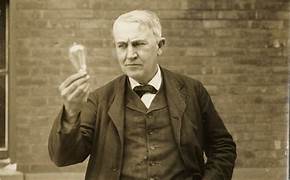On October 21, 1879, one of the greatest inventors in history, Thomas Edison, successfully demonstrated the practicality of his most famous invention - the incandescent light bulb. This pivotal moment not only revolutionized the field of lighting but also had far-reaching impacts on technology, industry, and everyday life. Thomas Edison had been working on developing a practical and commercially viable electric light bulb for years. Through countless experiments and iterations, he made significant advancements in the design and functionality of the bulb. On that fateful day in 1879, Edison successfully illuminated a carbonized cotton filament inside a glass bulb for over 13 hours. The invention of the incandescent light bulb was a game-changer. Prior to this breakthrough, gas lamps and candles were the primary sources of artificial light. These traditional lighting methods were not only less efficient but also posed significant safety risks. Edison's incandescent bulb offered a reliable and safer alternative, ultimately transforming the way people lived, worked, and played. The incandescent light bulb revolutionized industries such as manufacturing, transportation, and entertainment. It allowed factories and workshops to operate longer hours, increasing productivity. It also enabled the expansion of railways and street lighting, enhancing safety and extending the possibilities of urban development. Moreover, the incandescent bulb made it possible to extend the hours of entertainment venues, such as theaters and sports arenas. Edison's invention had a profound impact on people's daily lives. It brought light to homes, eliminating the need for candles and oil lamps. This not only made living spaces brighter but also significantly improved the quality of life, enabling activities to be carried out after sunset. The light bulb also played a crucial role in education, as it allowed for longer study hours and improved access to knowledge. Edison's success with the incandescent light bulb was not only a technological achievement but also a testament to his perseverance and innovative spirit. He had faced numerous challenges and setbacks during his pursuit of a practical electric light source. Through trial and error, he experimented with different materials, filament designs, and vacuum sealing techniques to overcome the limitations of earlier attempts. Following the successful demonstration of the incandescent bulb, Edison established the Edison Electric Light Company, which aimed to bring electric lighting to the masses. This marked the beginning of the widespread adoption of electric lighting and the subsequent development of electrical infrastructure. While the incandescent light bulb served as a groundbreaking invention, it was not without its limitations. The bulbs were relatively inefficient, converting only a small percentage of the electrical energy into light while the rest was lost as heat. Over time, advancements in lighting technology led to the development of more energy-efficient alternatives, such as fluorescent and LED bulbs. Nonetheless, Edison's incandescent light bulb laid the foundation for the modern lighting industry and paved the way for further advancements in electrical engineering and technology. It remains an iconic symbol of innovation and serves as a reminder of the power of human ingenuity to shape the world. Thomas Edison's invention of the incandescent light bulb on October 21, 1879, forever changed the way we illuminate our world. His dedication to solving the problem of practical electric lighting not only transformed the field of lighting but also propelled society into a new era of progress and convenience. The incandescent bulb stands as a testament to the power of invention and the lasting impact it can have on the world.
21 Oct, 1879 U.S.A. Thomas Edison
